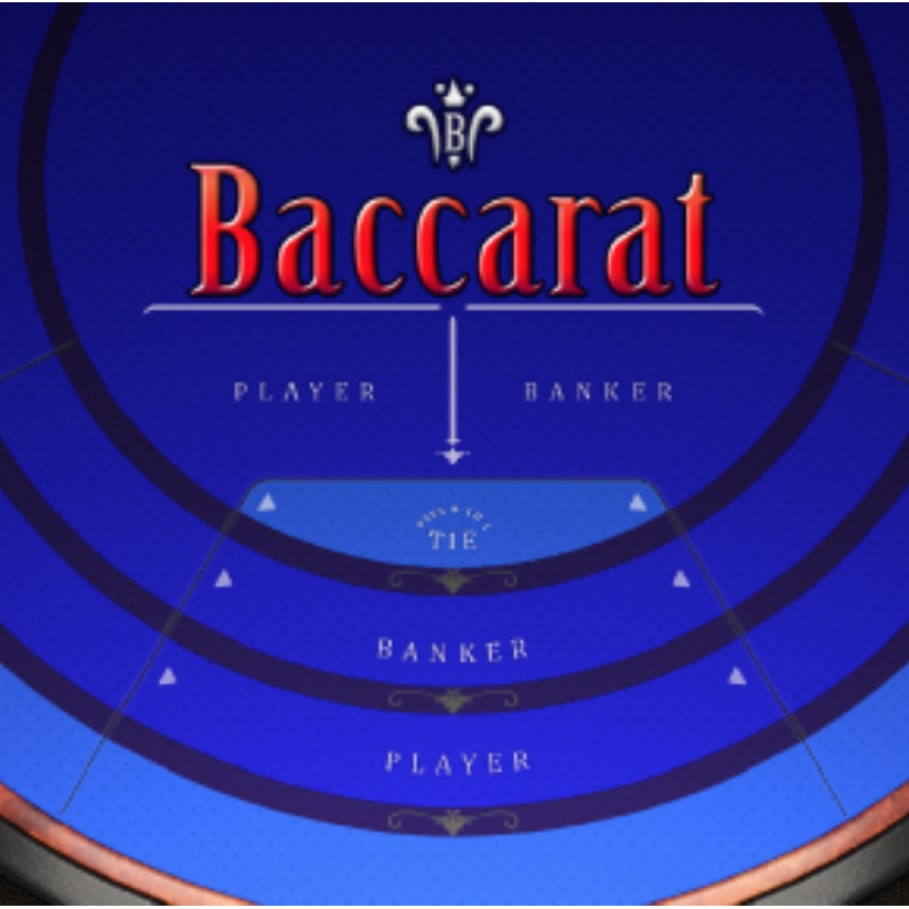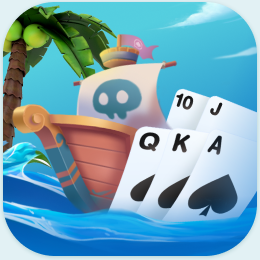How to Beat The Fish at Poker Games

‘Over 50 surprising specific methods for beating the “fish” and “donkeys” at online poker tables. One of my all-time popular strategy guides right here.’  by Josh H | Owner and Editor-in-Chief
by Josh H | Owner and Editor-in-Chief 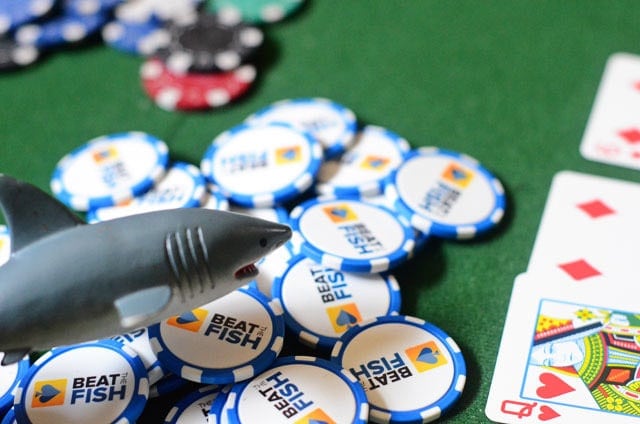 The surge of the online poker made the game available to people from all over the globe at any time of day and night. The popularity of the game attracted many inexperienced players to the tables
The surge of the online poker made the game available to people from all over the globe at any time of day and night. The popularity of the game attracted many inexperienced players to the tables
Josh’s updated notes: The following Beat The Fish strategy guide was actually the first piece I ever did for this site in the summer of 2005. I’ve fixed it up graphically (seriously, I was using Frontpage 2003 when I released it), but 95% of the text remains the same as it did when I put it out in those halcyon online poker heydays.
It not only remains special to me for sentimentality, but the advice I doled out after a couple years of online poker under my belt is still relevant today.
Beginners can still pick up a ton and I think more advanced players will still gleam a trick or two to earn a little extra profit.
A lot of the guide may seem like common sense to today’s players, but keep in mind that in 2005, quality No-Limit Hold’em strategy advice was still scarce. Guides designed specifically for beating the wild online tables of the day were virtually nonexistent.
That’s what my unique angle was: you might know how to play, but you need to adopt an entirely new set of rules for “the fish”. I hope you enjoy it as much as I enjoyed sharing it with hungry players all those years ago.
Table of Contents
-
My original “Beat The Fish” Guide
-
Part One: Where Did Online Poker Fish Come From?
-
Enter online poker
-
Enter the fish
-
Part Two: Preflop Play
-
Hand Selection
-
Suited Connectors
-
Playing Any Pocket Pair
-
Play the Opposite Style of Your Opponents
-
Overall Pre-flop Strategy
-
Part Three: Preflop and Postflop Play
-
Proper Play: Preflop
-
Proper Play: On the flop
-
The Board Flops a Pair
-
Don’t Slowplay Very Often
-
Letting Big Slick Go
-
Preflop and on The Flop: Alternative Method
-
Overall Strategy on the Flop
-
Part Four: The Turn and River
-
Playing Draws
-
Proper Play: Turn and River
-
Checking on the River
-
Checking on the Turn
-
Betting the Minimum
-
Know When You’re Beaten
-
Is Your Hand Counterfeited?
-
Discipline
-
Winning on the Turn and River
My original “Beat The Fish” Guide
With the surge that online poker has experienced in recent years the industry is at an all-time high. Whether players specialize in Texas Hold’em, Omaha Hi/Lo, 7 Card Stud, or even 5 Card Draw, a full table is never more than a walk from the couch away.
Unfortunately, experienced poker players have almost shied away from the online poker infiltration because of the recent influx of inexperienced poker players.
These clueless internet players are commonly called “fish” or “donkeys”. Isn’t the term “fish” a whole lot better, though?
I mean, why pick on poor donkeys? If you call these degenerates fish, you can naturally assume the poker “shark” nickname. Who preys on donkeys?
Anyway, while these unsuspecting players will often pay off better players with big hands, they will also draw out on those better players against the odds. Not only can this cost you a big chunk of your stack, it can cost you your patience and discipline as you go from proper poker play to the dreaded land of tilt, a situation where poker players lose their cool and thus play poorly after a bad beat.
Our strategy tutorial seeks to outline simple yet effective methods to beating the fish, which allows you to keep playing your game.
Part One: Where Did Online Poker Fish Come From?
The explosion of televised poker tournaments and lipstick cameras has ushered in a new era of poker popularity. Thousands of new players flocked to the game, mainly the Texas Hold ’em variation, hoping to emulate their TV heroes for fame and fortune.
 The revolution of televised poker created the boom, piquing the interest for the game among many who have never heard of the game before The logical starting place would be the local cardroom, where new players can try to improve their game against real players. Unfortunately, casinos don’t exist in many places of the country. Others may feel too intimidated to enter a physical cardroom for the first time.
The revolution of televised poker created the boom, piquing the interest for the game among many who have never heard of the game before The logical starting place would be the local cardroom, where new players can try to improve their game against real players. Unfortunately, casinos don’t exist in many places of the country. Others may feel too intimidated to enter a physical cardroom for the first time.
Enter online poker
Beginning in the early 2000s, startup companies began to cash in on poker’s new popularity and create online poker rooms. New poker prospects could play online anonymously from anywhere at anytime. Just fund your account, choose your game, and play your cards against thousands of real players from all over the world.
Over the years, online poker has become a booming industry. New players who’ve just watched Daniel Negreanu crush the competition at a WPT event rush over to their computers to deposit with the poker room with the coolest commercial. Thousands of inexperienced players can enter any online game so long as they have the buy-in.
Enter the fish
This is the new breed of online player. They’ve watched Chris Moneymaker take home a couple million bucks by putting in his whole stack with nothing. They’ve watched professionals raise with A-5 offsuit from late position and catch two fives on the flop. Why can’t they do it, too?
Usually, fish are harmless. Players who know their stuff, read and study poker books, and stay on top of their game can make a killing off of this type of player.
They’ll bluff off all of their chips when you have the nuts and you’ll love it. They’re also dangerous and can put you off your game.
How many times have you been online playing $1-2 No-Limit Hold ’em and raised 4x the big blind with A-K and get called by A-5 only to watch the flop come A-6-5 rainbow. “Great!”, you’re thinking as you reraise your clueless opponent for all his chips. You don’t catch a K on the turn or river and you’re left wondering why he stayed in the hand at all.
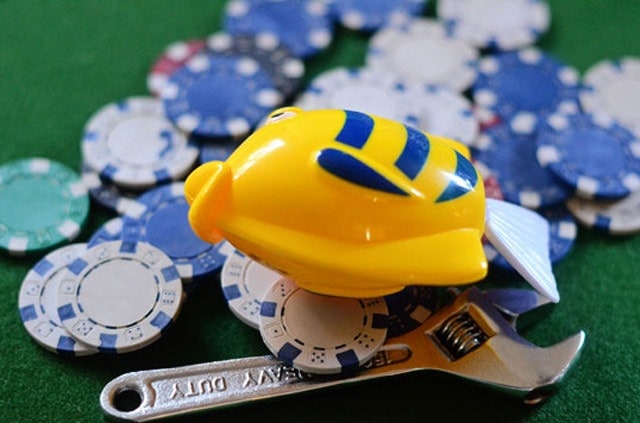 The combination of televised poker, with all its glamour, and the availability of online poker caused the surge of the fish to the virtual felt, looking to follow in the footsteps of their heroes You try to shrug it off and you get dealt pocket Aces the very next hand. Your fishy buddy has position on you so you just call the big blind from early position. Everyone folds to him who makes the minimum raise…
The combination of televised poker, with all its glamour, and the availability of online poker caused the surge of the fish to the virtual felt, looking to follow in the footsteps of their heroes You try to shrug it off and you get dealt pocket Aces the very next hand. Your fishy buddy has position on you so you just call the big blind from early position. Everyone folds to him who makes the minimum raise…
Why do these players do that so often? What’s the point? How many times have you seen this open up the betting action and the smooth caller comes back over the top of the minimum-raiser for a huge raise? Everyone folds. Why don’t they either call or make a real raise? Or why don’t they go find a Limit game if they’re going to play like that? Oh, well.
Anyway, everyone folds back to you and you just call the minimum raise hoping to trap the fish. The flop comes J-4-9 rainbow. Another seemingly great flop for you. You make a good pot-sized bet here and the fish comes over the top and raises you for all you’ve got! You decide to call as he turns over J-2 offsuit.
Finally you’ve got him! The turn brings a K and the river brings a deuce. You pound your computer monitor as you click to exit the poker room. You’re down $400 with two premium hands.
Why me? It happens. These are real hands that I’ve been involved in, and something similar will probably happen to you (if it hasn’t already) if you play online poker much. My goal is to teach you how to keep these situations to a minimum, and if it does happen anyway, how to deal with it without blowing off anymore of your chips.
The keys are hand selection, proper play, and discipline.
Part Two: Preflop Play
Hand Selection
I’m sure that you’ve read about hand selection and looked over your favorite author’s starting hand guide. It will tell you the recommended hands that you should play from early, middle, and late position.
There are exceptions, but their recommendations are usually a very good guide to use. If you want to keep yourself out of trouble and stay above the gutless play of the online fish, you’ll take your tight-aggressive author’s word and stick to good starting hands.
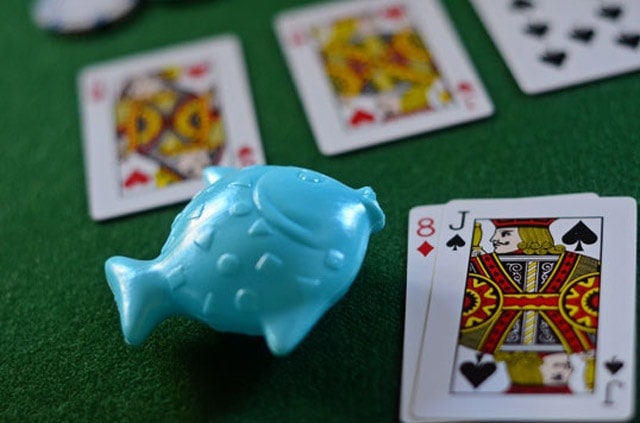 The key to successful online poker strategy is having a solid preflop hand selection. If you consciously try to not get involved with weak hands, you will avoid many marginal (and potentially expensive) situations I even kept a photocopy of Matthew Hilger’s starting hand guide from Internet Texas Hold ’em next to my computer for a while. And remember, we all play garbage like J-7 offsuit at times, but try to keep those temptations to a minimum. It’ll save you a lot of money in the long run.
The key to successful online poker strategy is having a solid preflop hand selection. If you consciously try to not get involved with weak hands, you will avoid many marginal (and potentially expensive) situations I even kept a photocopy of Matthew Hilger’s starting hand guide from Internet Texas Hold ’em next to my computer for a while. And remember, we all play garbage like J-7 offsuit at times, but try to keep those temptations to a minimum. It’ll save you a lot of money in the long run.
In Beat Texas Hold ’em, Tom McEvoy suggests that “it is unprofitable over the long run to play anything other than Aces, Kings, AK, and sometimes Queens from the first position.”
He’s right. Position is power in Hold ’em.
You can loosen your starting hand requirements as you get closer to the button, but play very selectively from early position. You’ll have to act first, and you won’t know where you stand unless you’re holding strong cards.
Most of your opponents will be playing a combination of good starting cards (even maniacs can wake up with AA) and bad cards. You’ll only be playing the good cards. Don’t sink to their level because you’ll probably be stuck with a borderline call that could cost you a lot of money.
More tips on Hand Selection:
- Texas Hold’em Hand Strength
Suited Connectors
Even though you’ll be playing big cards most of the time, keep an eye on the pot when you’re in late position. This is a great time to play suited connectors if 4 or 5 players are seeing the flop with you.
The pot odds justify a call from you in this situation, plus these types of hands can turn into real monsters if you hit the right flop. If you’ve been showing your opponents good cards, you may even consider a raise in this situation. Your opponents will put you on a couple of big cards, and it can pay off when you hit two pair or a set on the flop with your 4-5.
More tips on Suited Connectors:
- Small Suited Connectors
Playing Any Pocket Pair
A couple of table situations make it profitable to play small and medium pocket pairs (2-2 through 10-10) from any position. If you’re in late position and you have at least 4 or 5 callers ahead of you, definitely play any pocket pair.
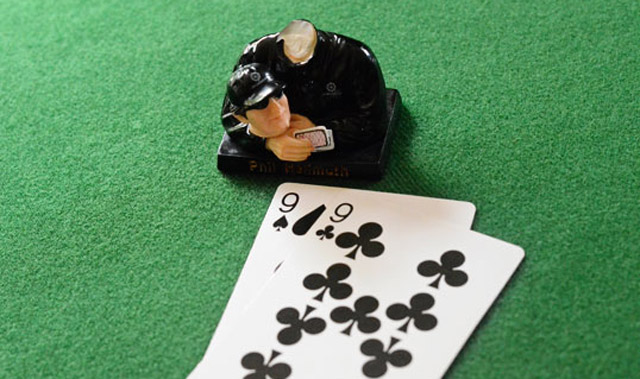 Playing small and mid pocket pairs can be an effective online poker strategy, but you need to be mindful of the odds and your position at the table Also, if your table is passive and you don’t encounter a lot of preflop raises, than you might consider playing any pocket pair from middle and late position. Just remember, if you don’t have an overpair to the board on the flop: no set, no bet!
Playing small and mid pocket pairs can be an effective online poker strategy, but you need to be mindful of the odds and your position at the table Also, if your table is passive and you don’t encounter a lot of preflop raises, than you might consider playing any pocket pair from middle and late position. Just remember, if you don’t have an overpair to the board on the flop: no set, no bet!
More tips on Pocket Pairs:
- Small Pocket Pairs
- Pocket Jacks
- Pocket Kings and Queens
Play the Opposite Style of Your Opponents
When your table is full of stupid players who are hitting big hands with trash cards, you might be tempted to play those same trash cards hoping to hit those monsters, too. You can try it. But the problem is that maniacs and fish like to intimidate other players by constantly raising the pot preflop. It’s going to cost you to see the flop, and most of the time you’re not going to hit anything with trash hands.
As Doyle Brunson recommends in Super System 2, you usually want to be playing the opposite style of the opponents at your table.
If your table is full of wild loose players, you want to tighten up and wait for the right cards to snap them off. I don’t suggest getting involved with mediocre hands and trying any fancy plays at most loose online tables.
Your opponents aren’t going to pay attention, and will probably call you down with any two cards. Doyle’s advice also works well if you’re playing at a tighter site like Bovada of BetOnline.
At a table full of tight players, I often mix it up with lots of pot-sized raises from late positions. Most of the time you’ll pick up the blinds and if you do get called, you can usually win it on the flop if all blanks fall.
Overall Pre-flop Strategy
- Good starting hands are the first defense against bad online players
- Be very selective from early position
- Loosen up your starting hand requirements as you gain position
- Consider staying in with suited connectors from late position with lots of callers
- Play small and medium pocket pairs in the right situations and remember: no set, no bet
- Don’t sink to the bad players level
- Play the opposite style of the rest of the table
Part Three: Preflop and Postflop Play
Proper Play: Preflop
The consensus among No-Limit Hold ’em experts is that a “standard” raise is 3-4 times the amount of the big blind. I agree for real cardroom poker. But online against loose players, one of the best defenses you have is increasing the amount of your “standard” raise, possibly to 5-6 times the big blind. If your online poker site has a “Bet Pot” button, raise at least by this amount.
By doing this, you make it a little harder for bad players to stay in with bad cards that will draw out on you. I definitely recommend a larger raise for tricky pocket pairs like K-K and Q-Q. If two players call your raise instead of five when you have K-K and an Ace comes on the flop, you are more likely to still be holding the best hand.
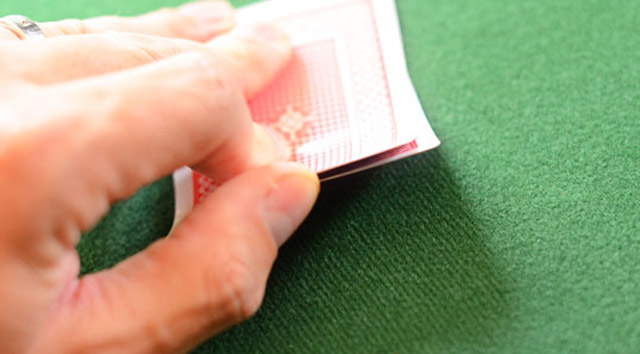 Be flexible with your preflop raise sizes. If you can get away with making 6 or 7x raises, then by all means do it with your big hands and charge the fish the maximum to follow you to the flop I can’t stress this enough about online poker: RAISE YOUR BIG HANDS AND RAISE THEM HARD! I’ve learned to rarely slowplay anything at all unless I have the absolute nuts. Slowplaying will just get you in trouble and often lose you a big pot, especially online. Lee Jones advocated this same style of play in Winning Low-Limit Hold ’em. He’s right.
Be flexible with your preflop raise sizes. If you can get away with making 6 or 7x raises, then by all means do it with your big hands and charge the fish the maximum to follow you to the flop I can’t stress this enough about online poker: RAISE YOUR BIG HANDS AND RAISE THEM HARD! I’ve learned to rarely slowplay anything at all unless I have the absolute nuts. Slowplaying will just get you in trouble and often lose you a big pot, especially online. Lee Jones advocated this same style of play in Winning Low-Limit Hold ’em. He’s right.
Sure, you’re often going to end up winning a small pot when no one wants to call your raise. Why get greedy? You won the pot, didn’t you?
It’s always better to win a small pot than lose a large one.
Tell me a single time where that isn’t true.
More tips on Pre-flop Play:
- The Facts on Minimum Raises
- Stealing the Blinds
NOW FREE: MY COMPLETE POKER BOOK LIBRARY
 - 5 complete ebook PDFs
- 5 complete ebook PDFs
- Previously only available to members
- No registration or email required
- checkBonus: Winning Sit and Go Secrets
Read now for free
Proper Play: On the flop
Okay, so you’re playing the right cards and raising them before the flop, now what? After you judge your own hand, you’ve got to get good and reading the board and reading your opponents. Always look for straight and flush possibilities.
Think of what the best possible hand is on the flop and what your opponent is likely to be holding.
Look for straight and flush possibilities. If you’ve been studying their play, you should be able to make a fairly good read on their possible hands. If you think that you have the best hand on the flop (usually at least top pair with a good kicker), protect it against loose opponents. Why let them draw out on you for cheap?
If I’m heads-up and out of position on the flop holding A-K offsuit with board of A-J-8 with two diamonds, I’m going to make at least a pot-sized bet to try to make my fishy opponent pay for his flush draw. The same thing goes if you see a straight draw on the board.
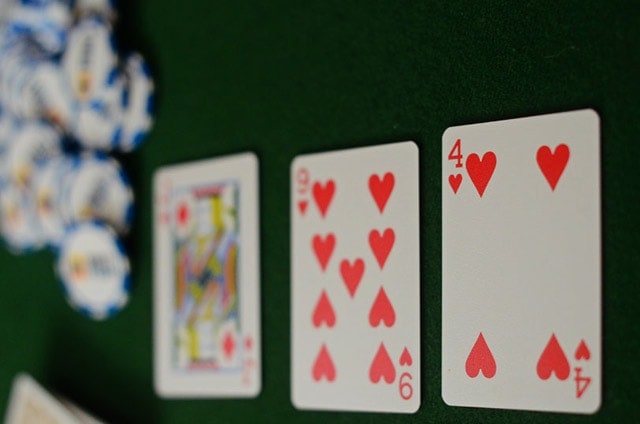 Protecting your hand on the flop is essential to your success. If the fish is drawing, make sure to charge them properly. If they are too stubborn to give up, show them how stubbornness can be very expensive Lots of players will play anything from any position, so no matter how unlikely it seems, you have to protect against any possible draw. If you have a strong hand with multiple opponents and two suited cards or two connected cards come on the flop, you’ve got to bet at it. And bet even more with multiple opponents.
Protecting your hand on the flop is essential to your success. If the fish is drawing, make sure to charge them properly. If they are too stubborn to give up, show them how stubbornness can be very expensive Lots of players will play anything from any position, so no matter how unlikely it seems, you have to protect against any possible draw. If you have a strong hand with multiple opponents and two suited cards or two connected cards come on the flop, you’ve got to bet at it. And bet even more with multiple opponents.
There is no worse crime than allowing your opponents to draw out on you for cheap or for free. Don’t do it!
The Board Flops a Pair
Be very careful when the board flops a pair, three suited cards, or three connected cards. A flop of J-4-4 rainbow might look harmless, but many bad players have the “Ace-anything” mentality and will routinely play A-4. Don’t bet much at that pot with A-J.
Also, one or more of your opponents is likely to have flopped a big hand with three suited or connected cards on the board. People like to play suited and connected cards, so I’d play extremely cautiously, especially if many opponents are seeing the flop with you.
If anyone bets a substantial amount in this situation and you don’t have the nuts or a draw to the nuts, you’ve got to lay your hand down.
Don’t Slowplay Very Often
Unless you have the nut straight, nut flush, a full house, or better – don’t slowplay on the flop! I will bet out the top set routinely, unless it is an unsuited board with no straight possibilities. I’ll check it down then. The fish will draw to anything. Don’t let them do it for free.
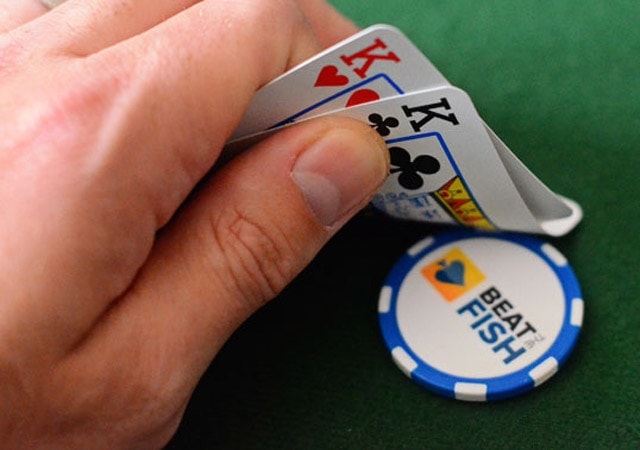 Slowplaying is a legit part of online poker strategy, but make sure not to use it too often, or you will find yourself in weird spots, facing huge bets, and having no idea if your hand is any good If you do hit something huge on the flop, then you’ve GOT to check it down. You’ve essentially crippled the possibilities of there being other good hands out there. If you want any action on your hand, check your hand and let them catch up a little on the turn and river.
Slowplaying is a legit part of online poker strategy, but make sure not to use it too often, or you will find yourself in weird spots, facing huge bets, and having no idea if your hand is any good If you do hit something huge on the flop, then you’ve GOT to check it down. You’ve essentially crippled the possibilities of there being other good hands out there. If you want any action on your hand, check your hand and let them catch up a little on the turn and river.
More tips on Slowplaying:
- Slowplaying on the Turn
- Pocket Aces (AA)
Letting Big Slick Go
A-K, often referred to as “Big Slick” is a drawing hand, not a made hand. It’s a great drawing hand because when you pair up the board, you’re going to have top pair with top kicker. But you’re only going to hit a pair on the flop with A-K about 1/3 of the time. The other 2/3 of the time if someone bets, just fold and be done with it.
Big Slick is nothing without help from the board, unlike A-A or K-K.
If you don’t pair up on the flop, you can try to take a stab at the pot if you’re heads-up and in position. Otherwise, check it down and fold to most bets. Why keep drawing with a very thin draw? That’s just a bad way to lose more money.
More tips on A-K:
- How to Play Ace-King Preflop
Preflop and on The Flop: Alternative Method
My poker mentor, who’s been playing poker for over 40 years, told me about an interesting method that helped him get through streaks of really bad beats. Sometimes he’ll play No-Limit hold ’em without ever raising before the flop. He’ll smooth call every hand he intends to play, regardless of how huge it is.
Of course if someone raises and he’s holding pocket Aces, he’ll probably reraise him back. But when he plays like this, he’ll usually just call with everything. He does this for one simple reason:
It teaches you to rely on the flop and read your opponents properly. It can also save you some money if the flop turns out really ugly for you.
Just call with all of your hands and read the flop. If you don’t get any help, obviously you’re out. If you do get help but the board is dangerous, see what the other players do. If they bet anything substantial, you must entertain the possibility on folding your hand.
An advantage to this method of play is when you’re holding K-K or Q-Q and the flop comes out with an Ace. You check and fold to a decent-sized bet. You saved money by not raising preflop. This can be a dangerous way to play if you don’t read the flop right, but it can be a good way to learn to read your opponents on the flop and can save you money in certain situations.
Overall Strategy on the Flop
- Always raise your strong hands, especially at loose tables
- Consider raising at least 5-6 times the big blind.
- Bet out hard on the flop to keep draws playing against the odds
- Be careful with a dangerous board against bad players – they play any two cards
- Don’t slowplay unless you have the absolute nuts
- Let go of A-K immediately if you don’t flop anything
- Consider only calling everything preflop for awhile if you’re on a bad beat streak
Part Four: The Turn and River
Playing Draws
Essentially, I recommend a flop it or fold it strategy for loose online hold ’em, especially for beginners and intermediate players. If you keep playing a drawing hand, you’re usually not going to hit your draw and you’ll usually be going against the odds to try.
If you flop an open-ended straight or flush draw, you’re a little worse than a 2-to-1 favorite to hit your hand if you stay in to the river. If you make a weak call on the flop, miss your draw on the turn and fold, then you might as well have calculated yourself a 4-to-1 favorite for seeing just one extra card.
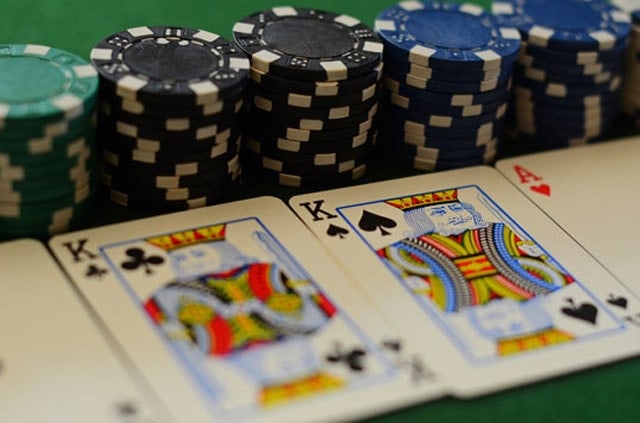 Playing draws incorrectly can be a very costly mistake. Make sure you know the exact odds and have a proper plan before putting your chips in the middle You’re usually going to need a couple of other players calling on the flop to get the right pot odds to continue with your draw. And I don’t recommend drawing out of position. If you’re last to act, at least you have one advantage over your opponents.
Playing draws incorrectly can be a very costly mistake. Make sure you know the exact odds and have a proper plan before putting your chips in the middle You’re usually going to need a couple of other players calling on the flop to get the right pot odds to continue with your draw. And I don’t recommend drawing out of position. If you’re last to act, at least you have one advantage over your opponents.
Plus, you can occasionally mix it up by raising with your drawing hand. This will make players tend to check to you on the turn, allowing you to check behind them if you miss your draw and bet again if you hit it.
One note on draws: drawing to the nuts or having two overcards greatly increases your hand’s value.
For example, if you have A-K suited and flop another two cards of your suit, you’ll have a draw to the nut flush and also outs to hitting your overcards and winning the pot.
More tips on Playing Draws:
- Betting Your Draws
Proper Play: Turn and River
Play in Texas Hold ’em, especially No-Limit, is defined by the flop. This is where you want to take control of the hand and you’ll pick up lots of pots by winning it right there. With many players drawing to straights and flushes, you also need to learn to adjust your play on the turn and river.
On the flop, you’re going to bet out with suited or connecting cards on the board. When you’re last to act, many opponents on a draw will make the weak play of checking and calling your bet. If the turn completed the flush or straight and your opponent has it, he’ll probably check to you again hoping to check-raise you or trap you into betting again on the river. Don’t fall for it.
I’ll often check behind them and make them bet on the river if they have a good hand. If he makes a big bet and there’s an obvious straight, flush, or set out there and you can’t beat it, think about laying your hand down.
If it’s a pretty small bet and the pot is a decent size, you’ll probably want to call and keep him honest. As Lou Krieger suggests, you can’t play being afraid of the nuts all the time. If you do, you’re giving up too often.

 BovadaSportsbook, Casino, and Poker Get up to a $750 instant cash bonusCLAIM NOWRead Review
BovadaSportsbook, Casino, and Poker Get up to a $750 instant cash bonusCLAIM NOWRead Review
 Ignition PokerCasino and Poker Get a 150% bonus for poker and casinoCLAIM NOWRead Review
Ignition PokerCasino and Poker Get a 150% bonus for poker and casinoCLAIM NOWRead Review
 BetOnlineSportsbook, Casino, and Poker Get a 50% bonus, up to $1,000 freeCLAIM NOWRead Review More tips on the Turn and River:
BetOnlineSportsbook, Casino, and Poker Get a 50% bonus, up to $1,000 freeCLAIM NOWRead Review More tips on the Turn and River:
- Raising on the River
Checking on the River
A very important play is knowing when to check on the river. If you’re first to act and you put your opponent(s) on a missed draw, there is no reason to bet out on the river. If you bet and they’re holding a missed draw, they’re just going to muck their hand.
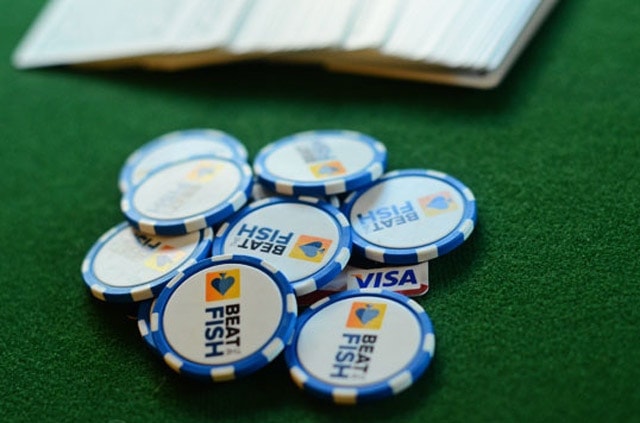 There is no reason to shy away from checking on the river. In most instances, by this point your opponent either has a hand that can’t call or he is looking to trap. This is not to say that you should never value bet the river, but checking has its advantages as well However, if you check, you send the signal that maybe you missed a draw, too. This gives your opponent the opportunity to bluff and you can make some extra money in the end. If they check behind you, you win the hand anyway and the pot is the same size as if they had folded their hand to your bet.
There is no reason to shy away from checking on the river. In most instances, by this point your opponent either has a hand that can’t call or he is looking to trap. This is not to say that you should never value bet the river, but checking has its advantages as well However, if you check, you send the signal that maybe you missed a draw, too. This gives your opponent the opportunity to bluff and you can make some extra money in the end. If they check behind you, you win the hand anyway and the pot is the same size as if they had folded their hand to your bet.
Checking on the Turn
This is a play that I like to use when I have a strong hand (usually at least two pair) and I don’t think my opponent can beat me. If I’m last to act, I’ll bet on the flop. Then when I get checked to on the turn, I check behind him. This will probably make your opponent think that you have a busted draw and you can make some extra money when you raise him on the river.
More tips on the Turn:
- Slowplaying on the Turn
Betting the Minimum
Another opportunity for a value bet comes on the river when you know that you have the best hand but you don’t think anyone else has much. Try betting the minimum amount. This can make your opponents suspicious and could induce a raise or they may have something good enough to call with.
At least you make a little extra in the end rather than betting your opponents out of the pot.
Know When You’re Beaten
Know when you’re beaten on the river. I see players time and time again calling a big bet with two pair or a set on the river when there’s four to a straight or flush showing. That’s not a good play.
The odds are very high that someone has one card to complete the straight or flush, especially with more than one opponent. I know that they shouldn’t have stayed in with the cards necessary to complete an 8-high straight, but they do. Usually you shouldn’t call a substantial bet in this situation without that flush or straight.
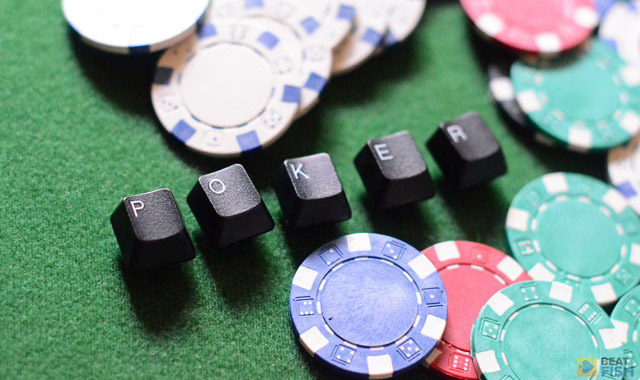 One of the key virtues of all successful poker players is the ability to recognize when they are beat and let go of their hand. As they say, there is little point in throwing good money after bad
One of the key virtues of all successful poker players is the ability to recognize when they are beat and let go of their hand. As they say, there is little point in throwing good money after bad
Is Your Hand Counterfeited?
Know when your hand is counterfeited – decreased in value by the board. If you get to see a free flop with 5-3 and the board comes J-5-3, you’re going to have a pretty strong hand. However, if the turn comes with another J, you don’t get credit for having three pair! You merely have two pair – Jacks and fives. Another holding a Jack has you beaten.
Discipline
This is the one facet of poker that is most under your control and yet can be the most difficult to master for some players. You must have discipline and patience to play winning poker. You must have the patience to wait for the right hands, and the discipline to stay off tilt.
Getting bothered by a player or angry by how the last hand turned out can be the undoing of your hard day’s work of poker.
It is difficult to combat and we all go on tilt at times, but you must learn to let the previous hand go before playing the next one. If you can’t, just sit out and walk around for a few minutes. The game will be there when you get back. Or try switching tables. In all honesty, you’re not making the best out of your poker career if you don’t have endless discipline and patience.
Winning on the Turn and River
- Don’t draw unless you’re getting the right odds
- Usually employ a “Flop it or Fold It” strategy
- Check behind your opponent if you think he made his draw
- Try checking behind your opponent with a strong hand on the turn and raising him on the river
- Check on the river if you think your opponent missed his draw
- Fold when you’re obviously beat on the river
- Know when your hand is counterfeited
- Patience and discipline are essential to poker
More tips on Beating The Fish:
- Defending Against Maniacs
- An Overview of Poker Bad Beats
That’s it. There are many specific situations that you’ll run into playing poker that I haven’t covered here, but I believe that this guide gives you a solid foundation to employing the right strategy for the craziness of online poker. If you follow the strategy that I have outlined, you should find yourself tearing your hair out less about the reckless idiot who drew out on your pocket Kings.
If you’re wondering which online poker room best suits your playing style, I’ve reviewed a number of them and given our opinions on each of them. If you’re looking for specific tips on how to play your favorite site, we have that in our reviews, too.
May you always beat the fish. I’ll see you at the tables… winning more.
Josh H( Owner and Editor-in-Chief )Josh is one of the world’s most respected online gambling experts. He has been featured on outlets such as CardPlayer, the World Poker Tour, Google News, and Forbes. Josh has nearly 20 years of experience reviewing poker rooms, casinos, and online sportsbooks. He launched Beat The Fish in 2005, which has been peer-certified as a trustworthy gambling portal. Josh’s proven systems and extensive knowledge of the iGaming industry have been used by thousands of online bettors to make more informed decisions.
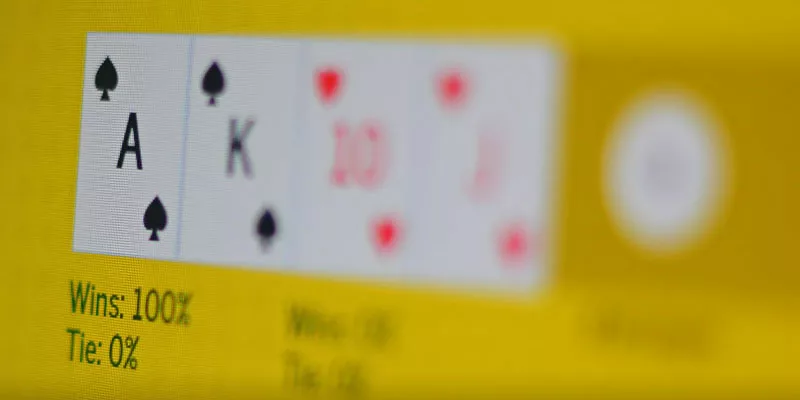 Simulate any Hold’em Hand
Simulate any Hold’em Hand
 The Easiest Poker Sites
The Easiest Poker Sites
 Our Top-Rated Betting Site Overall
Our Top-Rated Betting Site Overall
 Unbiased Casino Reviews
Unbiased Casino Reviews
 USA Online Poker Sites
USA Online Poker Sites
 How to Play Bitcoin Poker
How to Play Bitcoin Poker
 Full Review
Full Review
“As a USA player, I think Bovada is the best option. There are always a lot of games going on and the Bitcoin payouts get to me within an hour. No complaints.
Henry S.
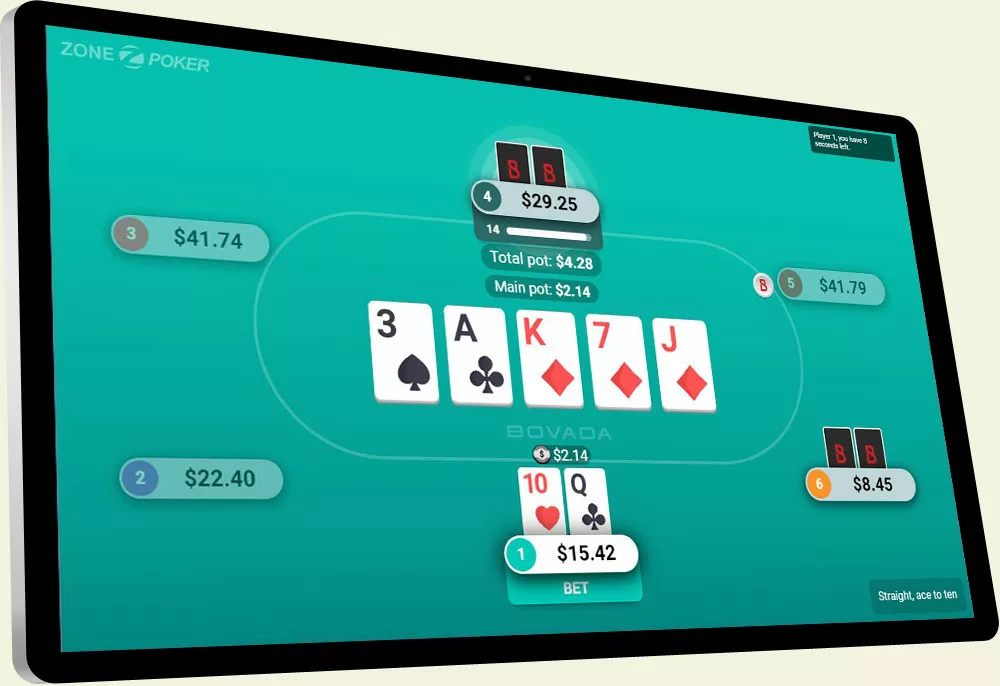 UP TO $3,750 BONUS
UP TO $3,750 BONUS
- Use crypto for extra bonus
- Most traffic in the USA
- Payouts within 15 minutes
- Full casino and sportsbook
Bonus on 3 deposits
plus
Cash rewards
Get My Bonus NowTest
FAQ
How to win at tournament poker?
The best approach is to play a tight range of strong and/or playable hands, and you need to play those hands aggressively. Playing all of your hands aggressively, including the more speculative ones like 7♠ 6♠ or 5♥ 5♣, allows you to disguise the strength of your actual hand.
How to win against fish poker?
By attempting to bluff them off of their hand you will simply lose much more money than you should have and also manage to tilt yourself even more! The correct and most profitable strategy versus the fish who doesn’t fold anything is to value bet the living crap out of them. And then value bet them some more!
What are some famous roulette scandals and controversies throughout history?
What are some famous roulette scandals and controversies throughout history? 1. The Eudaemons – In the 1970s, a group of physics students at the University of California Santa Cruz used a computer to predict the outcomes of roulette games in Nevada casinos. They called themselves “The Eudaemons” and made significant profits before their operation was shut down. 2. The Ritz-Carlton Scandal – In 2004, a team of Eastern European gamblers used a laser scanner and a computer to predict where the ball would land on the roulette wheel at the Ritz-Carlton casino in London.
How to spot a fish in poker?
One strategy of heads up play is to be very aggressive and keep leading out with bets and raising your opponents bets. Unfortunately many players become far too aggressive while playing heads up and do not consider the board and the possible hands that their opponents might have.
How to beat fish poker?
Try building the pot up over three streets but you want the fish to think “he’s trying to steal the pot/bluffing” vs “he has the nuts.” Also recognize common betting patterns your players have. They’re likely calling any Ax - ace rag. If they hit the ace then they’re going to be sticky so don’t bluff these people.10 thg 6, 2020
Why can I not withdraw my original deposit on WPT Global?
Why can I not withdraw my original deposit on WPT Global? You must wager the full amount of your deposit at least one time before requesting a withdrawal, as stated in our Terms and Condition. Once you do this, you can request your funds using the same method you used to deposit.
FishPoker – 集各種玩法於一身全新撲克平台! 這裡有多種經典和刺激的遊戲種類:NLH、Flash、SpinUp、AoF 以及PLO,不僅如此,還提供大菠蘿和十三張等遊戲模式。
This site only collects related articles. Viewing the original, please copy and open the following link:How to Beat The Fish at Poker Games













